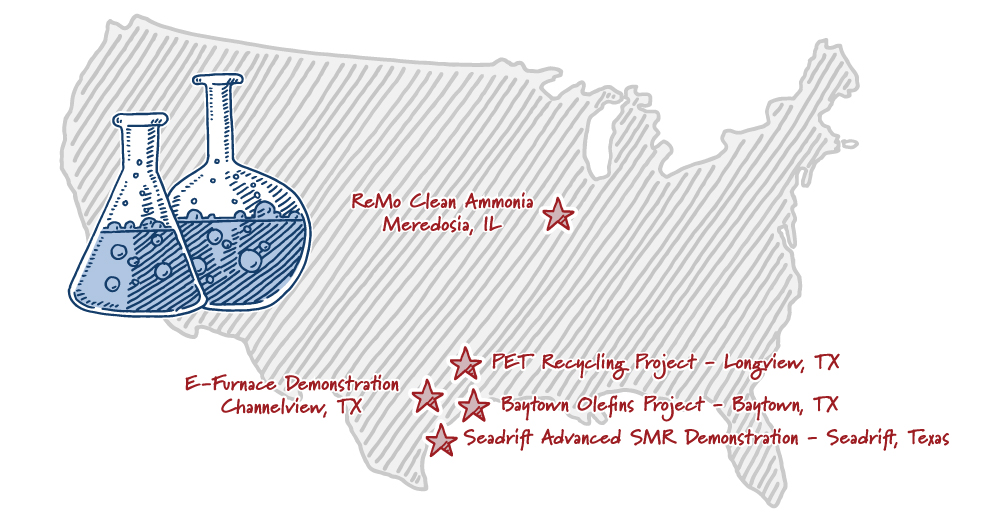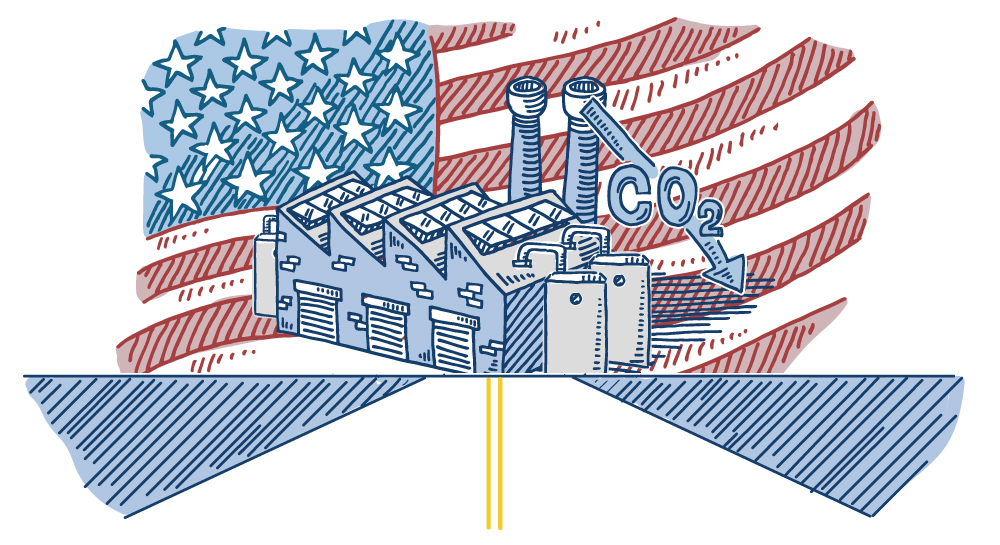Posted on October 17, 2024 by 250
Chemical production and refining play a critical role in producing essential fuels for, power, heat and transportation while also creating vital inputs for a wide range of products such as plastics, fertilizers and pharmaceuticals—key export commodities for the U.S.. Chemical production and refining processes are also the largest contributors to industrial CO2 emissions in the U.S. economy, accounting for 11 percent of energy-related emissions and a striking 37 percent of all industrial CO2 emissions. Those emissions are projected to increase by 20 percent by 2050, largely driven by a rise in demand for chemicals. As demand increases, the U.S. has the opportunity to lead the way forward in clean chemical manufacturing while reducing emissions.
The good news is that clean solutions do exist for the chemical sector. Let’s take a deeper look at announcements to date and what has yet to come.
Mapping the Top 5 Tech Innovations for Emission Reduction

Combining Nuclear with Clean Chemical Production: Seadrift Advanced Reactor
Dow and X-energy have partnered to deploy a groundbreaking small modular, high-temperature nuclear reactor at Dow’s chemical production site in Seadrift, Texas. This advanced reactor, equipped with four modules, is set to reduce site emissions by approximately 440,000 metric tons of CO2 equivalent per year. The project, backed by ARDP funding, marks a significant milestone as the first high-temperature gas reactor to be deployed domestically in the U.S.. Only one other reactor of its kind exists, which began operations in China in December 2023. This first-of-its-kind initiative will help decarbonize power and heat needs for industrial customers, positioning the U.S. as a leader in advanced nuclear technology for clean manufacturing applications. Construction is slated to begin in 2026, with operations expected to start by 2028.
Reducing Emissions with Electric Steam Cracking: Channelview E-Furnace Demonstration
Technip Energies, LyondellBasell and Chevron Phillips are collaborating on the design, construction, and operation of a demonstration unit for an electric steam-cracking furnace in Channelview, Texas. This innovative technology enables clean electricity to be a heat source for the olefins cracking process (a petrochemical process in which large hydrocarbons are broken down into smaller hydrocarbons), which is responsible for approximately 12 to 13 percent of CO2 equivalent emissions. Steam-cracking furnaces, which operate at over 1,500°F, play a vital role in breaking down hydrocarbons into olefins and aromatics — key building blocks for various chemicals. By switching to electric power, the new e-furnace has the potential to reduce greenhouse gas emissions by up to 90 percent compared to conventional furnaces.
PET Recycling Decarbonization Project: Eastman’s Circularity Initiative
Eastman is leading the way in plastic recycling with its first-of-its-kind molecular recycling facility in Longview, Texas, which aims to transform landfill-bound waste streams into virgin-quality polyethylene terephthalate (PET). PET is a kind of plastic derived from petroleum and is known for its durability, malleability, and widespread use in various fields (i.e., fiber materials, plastic bottles, etc.). The Longview facility, which has received up to $375 million in funding from the Department of Energy’s Office of Clean Energy Demonstrations, plans to use thermal energy storage coupled with on-site solar power to recycle approximately 110,000 metric tons of hard-to-recycle plastic waste. By doing so, Eastman’s process will create products that have 70% lower emissions than traditional products. When accounting for avoided incineration emissions, this figure rises to 90%.
Advancing Opportunities to Fuel Switch: ExxonMobil Baytown Olefins Project
Exxon’s Olefins Project in Baytown, Texas, is set to revolutionize ethylene production by using hydrogen in place of natural gas. Ethylene is a base chemical that is used as a feedstock for more complex chemicals, like polymers. This project, which has secured up to $331.9 million in federal funding, involves implementing new burner technology capable of using 100% hydrogen. The switch is expected to avoid 2.5 million tons of CO2 emissions annually, reducing site-wide emissions by approximately 30 percent of current operations. In addition to creating 400 construction jobs and retraining 140 workers, this project is a significant step in proving that clean hydrogen can decarbonize large industrial facilities. The successful demonstration of hydrogen fuel switching could provide a pathway for reducing emissions across the entire chemical industry.
Clean Feedstocks for Cleaner Ammonia: Trammo and ReMo Energy Pilot Project
Trammo, Inc., a raw materials distributor, and ReMo Energy, Inc., a clean chemical start-up, have signed a Memorandum of Understanding to produce clean ammonia at ReMo’s forthcoming plant in Meredosia, Illinois, which could be the first-of-its-kind in the U.S. ReMo will produce clean ammonia from clean hydrogen at a site co-located with Trammo’s existing ammonia terminal in Illinois. Trammo is the exclusive off-taker of ReMo’s ammonia. By optimizing the plant design with distributed scale and electrolyzer integration, ReMo aims to build ammonia production plants at a lower cost than traditional plants. This partnership represents a major step toward cleaner ammonia production, which is essential for reducing emissions from agriculture and other industries.

The Path Forward: U.S. Leadership in Clean Manufacturing
As the demand for chemicals grows, so do the challenges and opportunities in decarbonizing the U.S. clean manufacturing sector. By embracing advanced technologies such as small modular reactors, electric steam cracking, molecular recycling, hydrogen and others, America can lead the global shift towards cleaner, more innovative chemical production processes. This is not only an opportunity to reduce emissions but also an economic opportunity, as U.S. producers can utilize their emissions advantage over global competitors, particularly China, to access markets with demand for cleaner goods. Now is the time for the U.S. to build off this momentum and position itself as the global leader in reducing emissions through clean manufacturing.
